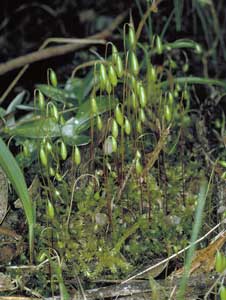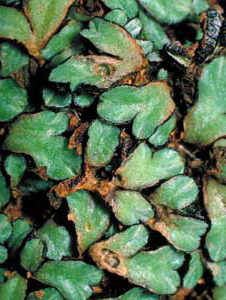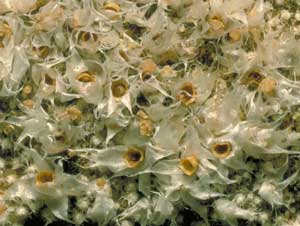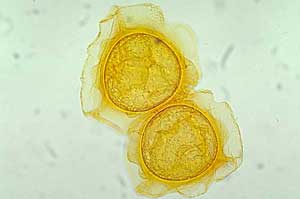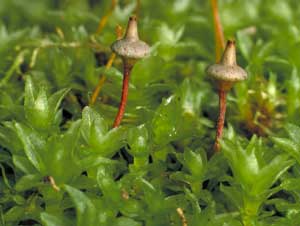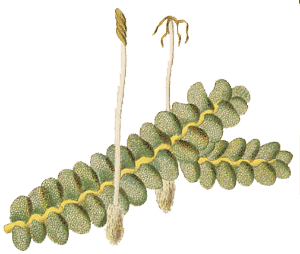
What is a bryophyte ?
If you read no more than this page, you will have a very basic, but good, understanding of the nature and ecology of bryophytes. Much of the rest of the website consists of expansions of the topics presented here and you can get to many of those expansions by clicking on the embedded links.
The word bryophyte is the collective term for mosses, hornworts and liverworts and bryology is the study of bryophytes. While there are marked differences between these three groups of organisms, they are related closely enough to warrant a single term that includes all three. So a moss is a bryophyte, a liverwort is a bryophyte and a hornwort is a bryophyte.
These are all plants, scientifically classified within the Plant Kingdom. They are spore-producing, rather than seed-producing, plants and they are all without flowers. Like any living organisms bryophytes are classified hierarchically. Related species are grouped into genera, related genera are grouped into families and so on. That topic is the subject of the CLASSIFICATION page.
In a moss plant you'll find leaves growing from stems and in many moss species you will at times see solid-stalked spore capsules growing out from the leafy part of the plant. In other species the spore capsule will be stalkless. Hornworts are not leafy. The main part of the plant consists of a greenish, flattish sheet - which may be lobed or somewhat wrinkled. This sheet-like form is called a thallose growth habit. In hornworts the spore capsules are thin, tapering “horns” or needles that grow out from the thallose part.
Here ![]() is a hornwort with a few immature capsules growing up from the thallose base. This photo
is a hornwort with a few immature capsules growing up from the thallose base. This photo ![]() shows a hornwort colony with numerous immature but more advanced capsules and here
shows a hornwort colony with numerous immature but more advanced capsules and here ![]() are mature capsules, now brown in their upper parts. Liverworts come in two growth forms, with both thallose species
are mature capsules, now brown in their upper parts. Liverworts come in two growth forms, with both thallose species ![]() and leafy species
and leafy species ![]() - with the latter having leaves on stems, just like mosses. Spore capsules are produced in various ways. In the thallose liverwort genus Riccia the capsules are embedded in the thallose sheet and in the picture (below right) you can see a couple of empty cavities within the thallose growth. Those are spore capsules which have opened and from which most of the spores have been dispersed.. In leafy liverworts and a number of thallose liverworts the capsules are atop stalks.
- with the latter having leaves on stems, just like mosses. Spore capsules are produced in various ways. In the thallose liverwort genus Riccia the capsules are embedded in the thallose sheet and in the picture (below right) you can see a couple of empty cavities within the thallose growth. Those are spore capsules which have opened and from which most of the spores have been dispersed.. In leafy liverworts and a number of thallose liverworts the capsules are atop stalks.
Many people are familiar with the thallose liverwort species Lunularia cruciata. It can form large colonies in glasshouses and in flower pots. However, while a few of the thallose liverwort species are quite conspicuous, there are far more leafy species than there are thallose species of liverworts.
In mosses and leafy liverworts the leaves are fairly small and in some cases the stems can be quite short as well. For more details about the structure of bryophytes go to the BRYOPHYTE GROUPS SECTION. That section is devoted to explaining what you see when you look at a moss, liverwort or hornwort. There you'll find out about the features you can see with the naked eye as well as some of the finer detail that a micoscope reveals.
After a brief discussion about “mossy things”, this section will continue with some basic facts about bryophytes in general and a brief account of the varied ecological roles they play.
Mossy things
Many people have some familiarity with “mossy things”. They’ve seen “mossy things” growing in their gardens, in cracks in footpaths (or even on footpaths), on tree trunks in parks and on boulders in the bush. To many people, anything smallish and green is labelled a “moss”. But is that sort of labelling correct? Certainly, many small, greenish organisms are mosses, but...
...not all “mossy things” are mosses !
There are various small, green organisms that are not mosses. In fact, the green-leaved plant shown in the painting at the top of this page is a leafy liverwort. Conversely, mosses aren’t always small and they aren’t always green.
You could expect that many people think of the closely related liverworts and hornworts as mosses. That certainly happens but, from the descriptions given above, hornworts and thallose liverworts are clearly quite different to mosses. However, leafy liverworts are obviously very similar to mosses, since they both have leaves on stems. Moreover, there are a few species of leafy liverworts that can be quite common in suburban gardens so that in many cases the leafy, “mossy” plants that people see are in fact leafy liverworts rather than mosses. How do you tell them apart? And if you have a thallose bryophyte, how do you know whether it’s a hornwort or a thallose liverwort? Some earlier links gave detailed descriptions of the separate bryophytes and there’s a summary of much of that information that let’s you answer the question: WHICH BRYOPHYTE IS IT?
However, there are other organisms, not at all closely related to bryophytes, but which (to many people) have a “green, mossy look”. Examples of these are various algae, lichens, filmy ferns and the smaller fern allies, such as the genus Selaginella. There are also some organisms which include the word “moss” in their common names but which are not mosses. A well known example is Spanish Moss - which is a flowering plant. You can find out more in the section that deals with WHAT’S NOT A BRYOPHYTE.
Getting back to mosses, on the right is a photograph of Gigaspermum repens, a moss with white leaves. There’s a lot of red in this photograph ![]() of a colony of the moss Polytrichum juniperinum - but they aren’t red flowers, they're leaves. Mosses don't have flowers.
Not to be outdone in colour variety here are two thallose liverworts, the green and white Riccia crystallina
of a colony of the moss Polytrichum juniperinum - but they aren’t red flowers, they're leaves. Mosses don't have flowers.
Not to be outdone in colour variety here are two thallose liverworts, the green and white Riccia crystallina ![]() and the red-margined Riccia cavernosa
and the red-margined Riccia cavernosa ![]() . Here’s a photograph
. Here’s a photograph ![]() of the moss Papillaria flavolimbata, which can grow in extensive curtains. It’s certainly not small.
of the moss Papillaria flavolimbata, which can grow in extensive curtains. It’s certainly not small.
This already indicates that there’s a lot more to mossy things than first meets the eye.
Bryophytes - some basic facts
Virtually all bryophytes contain chlorophyll and so make their own food from water and carbon dioxide, via photosynthesis. There is one liverwort (Cryptothallus) which lacks chlorophyll and relies on a fungal partner for food.
Bryophytes vary in size from plants only slightly over a millimetre tall to trailing species which grow to strands well over a metre long. A common misconception is that to find bryophytes you need to be in a damp, shaded streamside – preferably not in summer. In fact bryophytes can be found in great variety throughout the year in areas ranging from arid to rainforest, and in habitat from sea-level to alpine. They occur most abundantly in relatively unpolluted areas. Some species have specific habitat preferences while others are found in a variety of habitats. They can be found growing on all sorts of surfaces (or substrates) - soil, rock, tree trunks, leaves, rotting wood, bones, old discarded shoes or gloves – to name a few possibilities. Bryophytes don’t have true roots. They have root-like anchoring structures, called rhizoids ![]() , but these (unlike the roots of most plants) do not actively extract minerals and water from the substrate.
, but these (unlike the roots of most plants) do not actively extract minerals and water from the substrate.
Bryophytes and Water
A great many bryophytes are able to survive dormant during periods of extreme dryness or extreme cold and the species living in harsh environments have various survival mechanisms. Many moss species in such areas grow cushion-like ![]() , each cushion being a dense colony of individual plants. In this way most of the colony is protected from the direct effect of the harsh conditions. Many arid area bryophytes curl up in various ways to reduce their exposed surface areas. In various species the chlorophyll undergoes a change in structure in order to survive the dry periods undamaged. You’ll find natural anti-freeze in various cold-area bryophytes.
, each cushion being a dense colony of individual plants. In this way most of the colony is protected from the direct effect of the harsh conditions. Many arid area bryophytes curl up in various ways to reduce their exposed surface areas. In various species the chlorophyll undergoes a change in structure in order to survive the dry periods undamaged. You’ll find natural anti-freeze in various cold-area bryophytes.
Dormant bryophytes can become active with just a little water. It need not even be rain - fog or dew will be enough in many cases. This is why you can find bryophytes in deserts where rainfall may be very rare. In such areas the nights can still get cold, resulting in early morning dew formation - enough to bring the bryophytes out of dormancy. They can then photosynthesize for perhaps a few hours before the heat of the day forces them back into dormancy.
Most bryophytes absorb water and dissolved minerals over their surfaces - for example, through the leaf surfaces in many mosses and leafy liverworts. In cases such as this the absorbed water and minerals are immediately available in the places where photosynthesis occurs. Many bryophytes have various structural features which assist external water conduction. For example, overlapping leaves on stems; rhizoids with matted hairs; leaves that are ridged or with tiny warts (called papillae) or scales on the underside of a thallose bryophyte may help water move along the plant by capillary action. It is instructive to add a tiny drop of water to a mat of dry bryophytes and watch the water move through the mat. Ideally, watch the process under a low power microscope.
In a number of bryophytes water is conducted internally, as well as being absorbed in varying degrees through the plant surface. There are also varying degrees of development of the internal conducting system. In some the internal conducting system is fairly rudimentary. On the other hand, mosses in the families Polytrichaceae and Dawsoniaceae ![]() have robust stems with well-developed internal conducting systems. However, even in these cases the internal conducting systems are not developed to the extent they are in the flowering plants.
have robust stems with well-developed internal conducting systems. However, even in these cases the internal conducting systems are not developed to the extent they are in the flowering plants.
You can find out more in Volume 1, Chapter 7, of Janice Glime's Bryophyte Ecology website.
Reproduction & dispersal
Bryophytes may reproduce both sexually and asexually. In flowering plants the flowers are essential in the sexual reproductive cycle, with the pollen (the male gametes) from one flower typically being carried to another by wind, insects or animals. Once the pollen has been deposited it will fertilize the eggs in the receiving plant. Bryophytes have neither pollen nor flowers and rely on water to carry the male sperm to the female eggs. The spore capsules are produced after a male gamete (the sperm) has fertilized a female gamete (the egg). Hence the spores are part of the sexual reproductive cycle. In the majority of the bryophytes spore dispersal is by wind.
The gametes are produced on what’s called the gametophyte and the spore capsule (with its supporting stalk, if any) is called the sporophyte and this grows from the gametophyte. In mosses and leafy liverworts the stems and leaves make up the gametophyte. In hornworts and thallose liverworts the gametophyte is the flattish sheet. In bryophytes the gametophyte is persistent, with the sporophytes sometimes present for only a short time. The termination “-phyte” means “plant”, so the gametophyte is the “gamete plant” and the sporophyte is the “spore plant”. A germinating spore will eventually produce a new gametophytic plant and you can find more in the LIFE CYCLE SECTION.
Bryophytes can reproduce asexually in several ways. Simple fragmentation is one method. If, say, a fragment of a bryophyte gametophyte lands in a suitable habitat it can grow into a new plant. Many bryophytes produce what are called gemmae. Each gemma is a small aggregation of cells, capable of growing into a new plant. The gemmae may be produced in specialised structures, as tiny outgrowths from some part of the gametophyte or simply loose on the gametophyte. For example, here’s a picture ![]() of a gemma cup on the gametophyte of a species of Marchantia, a thallose liverwort. Within the small cup you can see some small green balls. Each of those is a gemma and may get splashed out by a raindrop or washed out by flowing water. In the moss Gemmabryum dichotomum the gemmae are so abundant amongst the leaves that they show up in this picture
of a gemma cup on the gametophyte of a species of Marchantia, a thallose liverwort. Within the small cup you can see some small green balls. Each of those is a gemma and may get splashed out by a raindrop or washed out by flowing water. In the moss Gemmabryum dichotomum the gemmae are so abundant amongst the leaves that they show up in this picture ![]() as simply a mass of brighter green.
as simply a mass of brighter green.
You can find out much more in the REPRODUCTION & DISPERSAL SECTION.
How do bryophytes differ from other plants ?
From what has been said above there's one clear difference between the bryophytes and the flowering plants. Bryophytes produce spores, rather than seeds, and have no flowers. But what about the ferns? They also have no flowers and produce spores. On the other hand ferns have well-developed, internal conducting systems that carry nutrients through the plant. The flowering plants also have such well-developed conducting systems, whereas bryophytes have, at best, relatively poorly-developed internal conducting systems. So, roughly speaking, ferns are intermediate between bryophytes and flowering plants, since they show some features of each.
All plants have gametophytes and sporophytes, but there is a considerable difference between the major plant groups as to which is the dominant stage. In the bryophytes the gametophyte is dominant. Gametophytes are persistent and, from time to time, gives rise to sporophytes. Spores produced by the sporophyte germinate to produce more gametophytes, which may then give rise to more sprophytes and so on. We speak of an alternation of generations, between the gametophyte and sporophyte phases. In the flowering plants the sporophyte is the dominant phase with the gametophyte reduced to just a few cells. Roughly speaking, ferns are in between.
You can find out more in the LIFE CYCLE SECTION. In that section you'll find a description of the bryophyte life cycle as well as a comparison between life cycles of the bryophytes and the other plant groups and the differing roles of gametophyte and sporophyte.
How many bryophytes are there - and what's known about them ?
There are estimated to be between about 12,500 and 15,000 bryophyte species known in the world, with about 2,000 from Australia. Here are the estimated numbers of species in each of the three BRYOPHYTE GROUPS:
|
mosses |
liverworts |
hornworts |
World |
8,000 - 10,000 |
4,500 - 5,000 |
100 - 150 |
Australia |
1,100 |
900 |
30 |
Many parts of the world are without resident bryologists, so that knowledge of the bryophyte variety in those areas has been gained in a haphazard way, typically from visits by bryologists resident elsewhere. This means that some areas of the world have been well-studied, from a bryological perspective, while others are largely unexplored. For example, knowledge of African bryophytes is generally fairly poor and in Australia the greatest number of species are recorded from eastern Australia. In the Australian case, that may well reflect the concentration of bryologists, rather than species, in eastern Australia. In the years since European settlement, there have been few bryologists resident in Australia and you can read more in the section dealing with the HISTORY OF AUSTRALIAN BRYOLOGY.
Despite the patchy knowledge about the world's bryophytes, various distribution patterns do show themselves. There are virtually cosmopolitan species (e.g. the thallose liverwort Lunularia cruciata ![]() ), Gondwanan species, Australasian species, polar species...and numerous other patterns down to those with a very restricted distribution. An example of the last is Tayloria gunnii, a species with very striking spore capsules, which is found only in Tasmania. There's more on the subject of bryophyte distributions in the section on BRYOGEOGRAPHY. Some of the widespread species are undoubtedly naturally widespread while others have been inadvertently dispersed by humans.
), Gondwanan species, Australasian species, polar species...and numerous other patterns down to those with a very restricted distribution. An example of the last is Tayloria gunnii, a species with very striking spore capsules, which is found only in Tasmania. There's more on the subject of bryophyte distributions in the section on BRYOGEOGRAPHY. Some of the widespread species are undoubtedly naturally widespread while others have been inadvertently dispersed by humans.
Ecology
Bryophyte ecology is a large subject. For the moment we’ll deal with various aspects by means of very brief summaries. All of these aspects (plus some others) are covered in more detail in the section on BRYOPHYTE ECOLOGY.
Extensive carpets of bryophytes on soil help in moisture conservation and flood control. During sudden downpours numerous species can quickly absorb (and retain) many times their dry weight in water. The absorbed water is then gradually released over a longer period, reducing the erosive effects of heavy rain and allowing other plants to benefit for a longer period from the rain. Bryophytes are also good at trapping nutrients from the air. This is the case for bryophytes that carpet the ground, but even more so for the curtains of bryophytes that are common in moist areas, such as rainforests ![]() . As mentioned above, most bryophytes absorb nutrients through their surfaces. An extensive bryophyte curtain has a large surface area. This means there's a large area through which the curtain can absorb the nutrients carried by water in mist or rain. These nutrients eventually become available to other organisms, for example if something eats a bryophyte or after a bryophyte dies and decays.
. As mentioned above, most bryophytes absorb nutrients through their surfaces. An extensive bryophyte curtain has a large surface area. This means there's a large area through which the curtain can absorb the nutrients carried by water in mist or rain. These nutrients eventually become available to other organisms, for example if something eats a bryophyte or after a bryophyte dies and decays.
Some species are very effective sand and soil binders and can help in dune stabilization and erosion control. In arid areas bryophytes, in association with lichens, can create extensive crusts on the soil and such crusts help maintain the underlying soil structure.
Bryophyte colonies provide niches for numerous invertebrates, often the very tiny invertebrates, which are then eaten by larger invertebrates which, in turn, are eaten by other creatures. Such bryophyte colonies are thus indirectly important in various food chains.
Bryophytes are often the first plants to colonize barren surfaces (e.g. road cuttings, rock outcrops and volcanic ash) and prepare these areas for later plants by trapping moisture and windblown organic debris and then contributing to the organic deposits when they themselves die and decay. This photo ![]() shows an extensive moss carpet growing over a large rock outcrop in a Western Australian sclerophyll forest. Here
shows an extensive moss carpet growing over a large rock outcrop in a Western Australian sclerophyll forest. Here ![]() is a closer view of another moss mat (on rock) in which numerous vascular shrubs and herbs have established themselves. In this photo
is a closer view of another moss mat (on rock) in which numerous vascular shrubs and herbs have established themselves. In this photo ![]() you can see numerous red Drosera plants (as well as some Siphula, a whitish lichen) in a carpet of moss. Moss carpets can also assist the seeds of flowering plants in germination by providing a moist seed bed. On the other hand, some bryophytes may inhibit the germination of the seeds of certain plant species. In short, there are many types of interactions between bryophytes and other plants.
you can see numerous red Drosera plants (as well as some Siphula, a whitish lichen) in a carpet of moss. Moss carpets can also assist the seeds of flowering plants in germination by providing a moist seed bed. On the other hand, some bryophytes may inhibit the germination of the seeds of certain plant species. In short, there are many types of interactions between bryophytes and other plants.
Some aquatic bryophytes participate in rock formation by absorbing minerals dissolved in the water. When dead, the plants sink to the bottom and so deposit the absorbed minerals.
Never say die
White winged choughs (Corcorax melanorhamphos) are common birds in the grounds of the Australian National Botanic Gardens. When feeding they flick leaf litter or mulch aside with their solid beaks and use those beaks to dig into the soil in search of invertebrates. Choughs work in groups of 10 or so and can turn over a considerable amount of leaf litter - or mosses. One area that sees chough visits is a garden bed with a long-established colony of the moss Campylopus introflexus. In this species numerous stems grow close together to form a dense moss carpet. In such a dense carpet active, photosynthesizing leaves will be confined to the upper parts of each stem since the lower stems would be too heavily shaded. Moss carpets are often homes to invertebrates and a moss carpet presents no obstacle to a chough. The bird will simply pull out or flick away chunks of moss in its search for food. What of a fragment that lands upside down? In an overturned fragment the leaves are cut off from the sun, unable to photosynthesize and so the plant would die - right? No. New stems and leaves start growing from the base (now top) of the fragment and from the stems. This photo ![]() shows such an upturned fragment, with many new shoots growing from various parts of the fragment. Various mosses show such behaviour, some to such an extent that over time, once a clump has been dislodged a number of times in different directions and shoots have grown from all sides, the result is a somewhat-ball like clump with shoots from all directions - a moss ball.
shows such an upturned fragment, with many new shoots growing from various parts of the fragment. Various mosses show such behaviour, some to such an extent that over time, once a clump has been dislodged a number of times in different directions and shoots have grown from all sides, the result is a somewhat-ball like clump with shoots from all directions - a moss ball.
Looking for bryophytes - and microhabitats
It's already been said that you can find bryophytes almost anywhere in the non-marine world, so you're bound to come across them. Sometimes it's easy to make sense of what you see, but at other times it's more of a challenge. There's no difficulty in seeing this curtain ![]() of the moss Papillaria flavolimbata. Moreover all of this curtain is the one species. At the other extreme there are many small bryophytes and very often you'll find different bryophytes growing together. This photo
of the moss Papillaria flavolimbata. Moreover all of this curtain is the one species. At the other extreme there are many small bryophytes and very often you'll find different bryophytes growing together. This photo ![]() shows two mosses, an unidentified green species and the silvery Erpodium hodgkinsoniae growing intermixed. Given the colour contrast it's easy to see that there are two species here. This photo
shows two mosses, an unidentified green species and the silvery Erpodium hodgkinsoniae growing intermixed. Given the colour contrast it's easy to see that there are two species here. This photo ![]() shows some thallose bryophytes. The darker green area is a hornwort in the genus Megaceros and the thallose liverwort genus Riccardia makes up the brighter green area. In that brighter green area there are in fact two species - Riccardia colensoi and Riccardia bipinnatifida. Telling the hornwort from the liverworts is fairly easy, since there's enough of a difference in the shades of green, but to distinguish one Riccardia from the other needs a much closer look, down on your hands and knees. Finally, this photo
shows some thallose bryophytes. The darker green area is a hornwort in the genus Megaceros and the thallose liverwort genus Riccardia makes up the brighter green area. In that brighter green area there are in fact two species - Riccardia colensoi and Riccardia bipinnatifida. Telling the hornwort from the liverworts is fairly easy, since there's enough of a difference in the shades of green, but to distinguish one Riccardia from the other needs a much closer look, down on your hands and knees. Finally, this photo ![]() shows part of a rock wall at the Australian National Botanic Gardens, with mosses growing in the joints between the separate stone slabs. There are at least three different moss species (in three different genera) shown in this view. In this instance you definitely need to look very closely, with a hand lens, in order to distinguish the three species. This photo also illustrates the significance of MICROHABITATS. From a bryophyte perspective, the microhabitat in the joints is different to that on the face of a rock slab. Microhabitats are very important to bryophytes so, when looking for bryophytes you need to be aware that as you walk a few metres you may well be passing through a variety of microhabitats, each providing different growing conditions and each host to different bryophytes. Here
shows part of a rock wall at the Australian National Botanic Gardens, with mosses growing in the joints between the separate stone slabs. There are at least three different moss species (in three different genera) shown in this view. In this instance you definitely need to look very closely, with a hand lens, in order to distinguish the three species. This photo also illustrates the significance of MICROHABITATS. From a bryophyte perspective, the microhabitat in the joints is different to that on the face of a rock slab. Microhabitats are very important to bryophytes so, when looking for bryophytes you need to be aware that as you walk a few metres you may well be passing through a variety of microhabitats, each providing different growing conditions and each host to different bryophytes. Here ![]() is another example of a bryophyte, the moss Gemmabryum dichotomum, exploiting a microhabitat that is located in this
is another example of a bryophyte, the moss Gemmabryum dichotomum, exploiting a microhabitat that is located in this ![]() macro-habitat.
macro-habitat.
As well as finding bryophytes growing with other bryophytes, you'll also often find them growing with OTHER CRYPTOGAMS. In this photo ![]() you can see a very dark green band of moss extending diagonally from near the upper left corner towards the lower right. Equally obvious is a great mass of a low-growing greyish lichen in the genus Siphula. A little to the right the cauliflower-like growths are colonies of a lichen in the genus Cladia. To the left of that band of moss the "bare" rock is home to lichens in the genus Xanthoparmelia.
you can see a very dark green band of moss extending diagonally from near the upper left corner towards the lower right. Equally obvious is a great mass of a low-growing greyish lichen in the genus Siphula. A little to the right the cauliflower-like growths are colonies of a lichen in the genus Cladia. To the left of that band of moss the "bare" rock is home to lichens in the genus Xanthoparmelia.
Are they simple plants ?
Bryophytes are often considered to be amongst the simplest and most primitive of plants in that, unlike the ferns and flowering plants, they haven’t a well-developed system for conveying nutrient solutions along their stems. Such a conveying system is called a vascular system and hence bryophytes belong to the group of non-vascular plants. Bryophytes lack true roots though many species have root-like anchoring rhizoids. But how simple or primitive are they? Consider the following evidence:
- bryophytes produce many phenolic and related compounds that deter herbivores;
- they were on the earth before the flowering plants and are still here;
- they inhabit a variety of habitats - even exposed arctic rocks, dark forest logs, acid bogs, tree trunks, boulders washed by fast-flowing streams, weathered bones and glass surfaces;
- how many vascular plants could survive long periods of desiccation without any underground organ or specialized resting structure? Moreover, bryophytes and their chlorophyll can survive intense light while dehydrated, a combination that would quickly fade a vascular leaf;
- how many other plants can grow during periods of sub-zero temperatures?
After taking all this into account one bryologist commented that along with the insect that survives any earthly holocaust there will be a forest of moss to give it shade and shelter.
![An Australian Government Initiative [logo]](/images/austgovt_brown_90px.gif)


